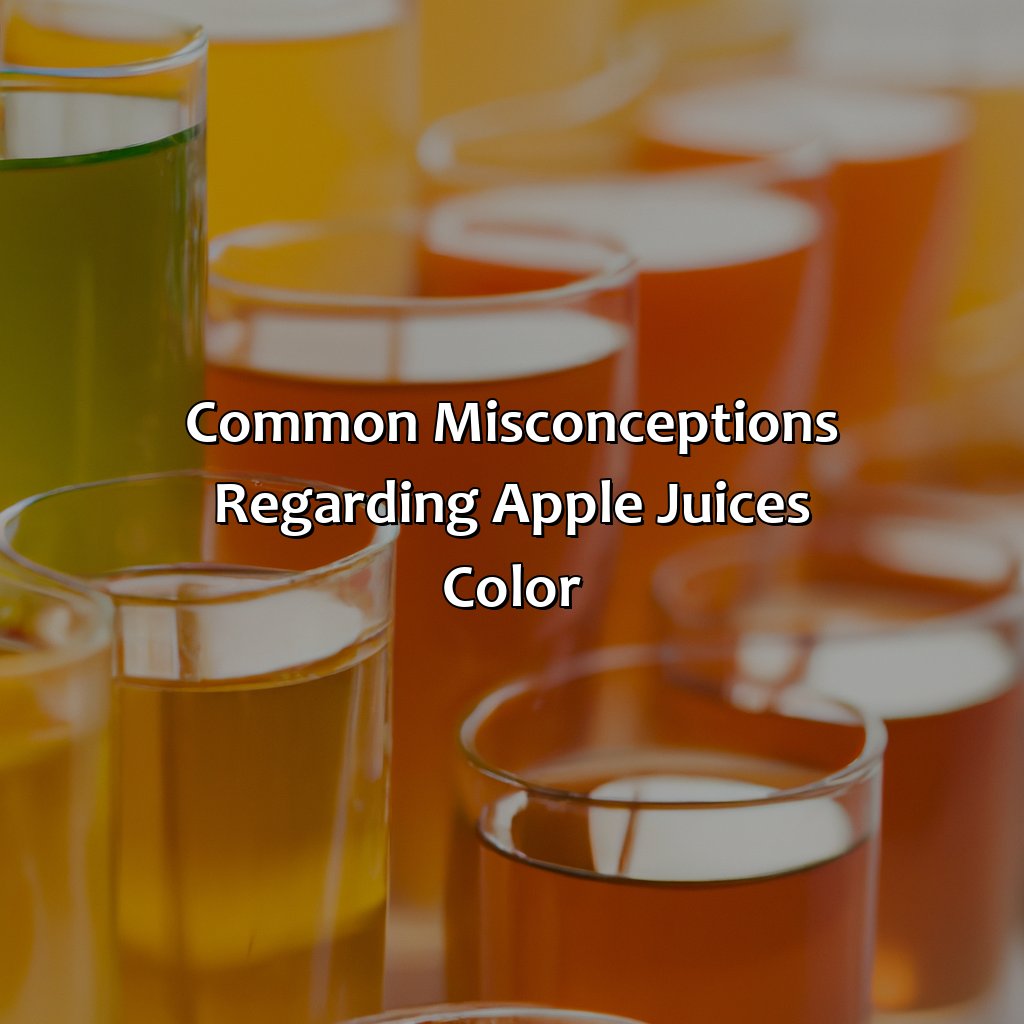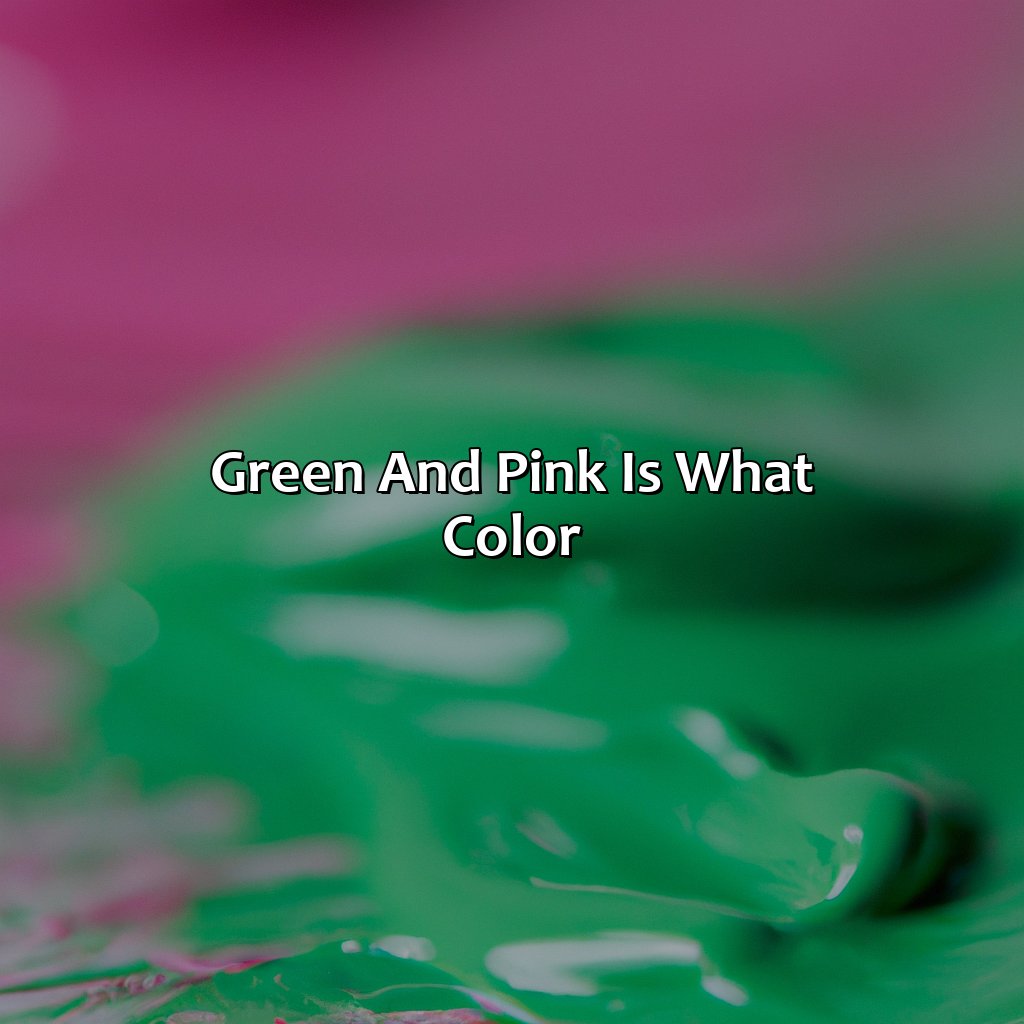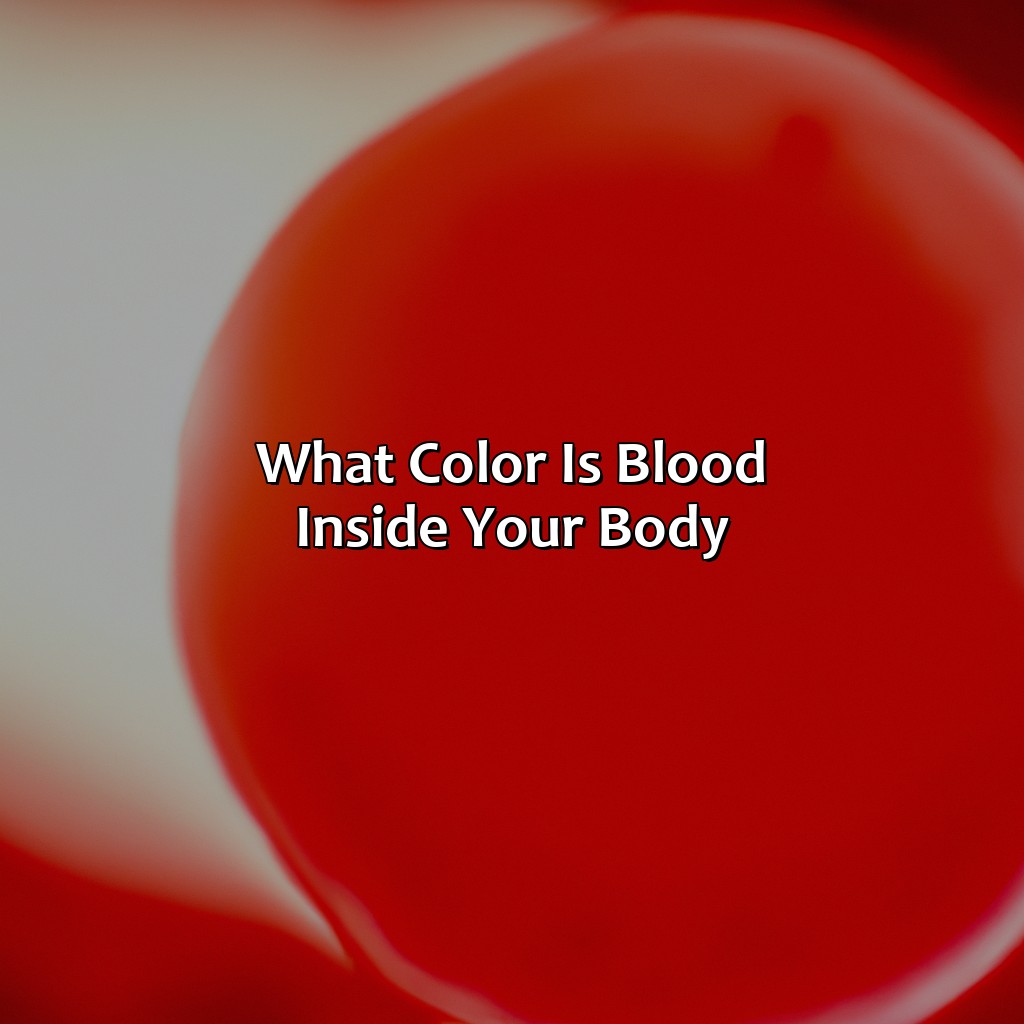Key Takeaway:
- Apple juice can range in color from a light golden to a dark brown depending on factors such as the variety of apple, ripeness, harvest time, storage, and preservation techniques.
- The pigments present in apples, such as anthocyanins and chlorophyll, can significantly affect the color of the resulting juice. Processing methods, such as enzymatic browning and pasteurization, can also impact the final color.
- Clear apple juice is not necessarily more nutritious than cloudy apple juice, and the color of apple juice is not an indication of its quality or taste. Other fruit juices can also vary in color based on similar factors.
The Science Behind Apple Juice’s Color

Photo Credits: colorscombo.com by Willie Thomas
To grasp the science of apple juice’s hue, discover pigments in apples and how processing affects the juice color. Pigments such as anthocyanins, carotenoids, and chlorophyll bring out the natural color of the juice. But, processing techniques like filtration and enzyme treatment alter the color, clarity, and taste of juice.
Pigments Present in Apples and Their Effect on Juice Color
Apples contain various pigments that affect the color of juice. Here’s a breakdown of each pigment and its effect on apple juice color:
| Pigment | Effect on Juice Color |
|---|---|
| Chlorophyll | Gives unripe apples and apple juice a green tint. |
| Anthocyanins | Gives red, pink, and purple hues to ripe apples and apple juice. |
| Carotenoids | Gives yellow and orange tones to ripe apples and apple juice. |
Interestingly, anthocyanins are sensitive to changes in pH levels during processing, which can alter their color intensity. Additionally, heat during pasteurization can also break down some pigments, resulting in lighter-colored juice.
It’s important to note that different types of apples have varying amounts of these pigments, which can result in different colors of juice. The ripeness and time of harvest also play a role in determining the final color.
A study published in Food Science & Nutrition found that apple storage conditions (such as temperature and duration) can also impact the concentration of pigments in the fruit, which ultimately affects the color of the juice.
Fun fact: According to a report by USDA National Agricultural Statistics Service, Washington state produces the most apples among all U.S. states.
Juice processing can turn a perfectly good apple into a shade of brown that would make Willy Wonka proud.
Impact of Processing Methods on Juice Color
Processing Methods That Affect Apple Juice’s Color:
Apple juice color can be impacted significantly by the processing methods used. Here’s how it affects juice color –
| Processing Method | Impact on Juice Color |
| Cold-Pressed | Produces a turbid, pulpy and darker juice due to oxidation, enzymatic browning and clarification |
| Hot-Filled + Cold Aseptic Filling | Makes the juice clearer and purer due to minimal air exposure, filtration and pasteurization. |
| Frozen Concentrate + Reconstitution | Can lead to slight variations in color due to concentration process but mostly maintains the original juice color. |
It should be noted that the processing methods also affect the nutritional profile of apple juice.
Pro Tip: Using enzymes like pectinase or xylanase in cold-pressed juices can improve clarity and brighten colors by removing some of the hazy pulp particles.
Apple juice color can depend on the apple variety, ripeness at harvest time, and storage/preservation methods – so basically, it’s like a mood ring in a glass.
Factors That Affect Apple Juice’s Color

Photo Credits: colorscombo.com by George Hall
To know what affects the color of apple juice, look at the apple variety, ripeness, harvest time, storage, and preservation techniques. Each factor impacts the juice’s color. Apple variety is a factor. Learn how ripeness and harvest time affect it too. Storage and preservation techniques can change the color of apple juice. Explore it all!
Apple Variety
Apples come in a diverse range of colors, sizes, and varieties. The choice of apple variety used for making juice has a significant impact on the juice’s color.
| Apple Variety | Juice Color |
|---|---|
| Red Delicious | Bright red |
| Granny Smith | Light green |
| Gala | Pale yellow |
| Honeycrisp | Golden hue |
| Braeburn | Amber tint |
Every apple variety has its unique pigments that give it a specific color. For example, Red Delicious apples are red because they contain anthocyanins and chlorophylls, while Granny Smith apples are green due to their high chlorophyll content. Apple juice made from different varieties will exhibit different colors based on this factor.
Did you know that the same apple can produce varying shades of juice depending on factors like geography and weather conditions? So even if you use the same type of apple from season to season, the color may vary.
A farmer once shared a story about how their apple orchard was impacted by drought-like conditions one year. It led to smaller-sized apples with duller hues compared to previous years when conditions were favorable. Nonetheless, they processed the apples into juice and bottled them without additives or preservatives. The resulting apple juice had a lighter color despite using the same variety, highlighting how external factors play a crucial role in determining apple juice’s color.
When it comes to apple juice color, the ripeness and harvest time of the apples can make all the difference between a vibrant hue and… well, dishwater.
Ripeness and Harvest Time of Apples
Apples’ Maturity and Harvesting Period’s Influence on Juice Appearance
Ripeness and harvesting time are critical factors that impact apple juice’s production and appearance. Apples’ maturity level, which depends on several factors, including seed development, skin coloration, texture, sugar content, and acidity, can indicate their optimal blending time for juice. Research shows that using ripe apples enhances the flavor profile and yields more natural-color juice than under-ripe fruit. For instance, when matured to 80-85% red skin coloration, Red Delicious apples exhibit desirable color retention after juicing.
The following table below outlines the optimal harvest period based on apple cultivar and intended use:
| Apple Variety | Harvesting Time | Best Use |
|---|---|---|
| Granny Smith | Late September to early October | Tart or hard cider |
| McIntosh | Mid-September to mid-October | Fresh drinking juice |
| Gala | Late August to early September | Fresh drinking juice |
| Fuji | Late September to mid-October | Canning or processing juice |
It is also crucial to note that proper storage techniques play a critical role in maintaining the apples’ ripeness level until juicing. For example, temperature stabilization, oxygen reduction through inert gas-flushed storage rooms or modified atmosphere packaging (MAP), controlled humidity levels delay fruit quality degradation beyond their peak harvesting time.
As such, incorporating ripe apples at their optimal harvest period supports nutritious juice production with desirable appearance while adhering to sustainable waste management practices.
Fun Fact: The oldest recorded recipe for apple cider vinegar dates back over 5000 years ago to ancient Babylonian times.
Want to keep your apple juice looking fresh? Store it in a time capsule.
Storage and Preservation Techniques
Color of apple juice can be influenced by various factors including the storage and preservation techniques used. Here are some important points to keep in mind:
- Apples should be stored in a cool and dry place to maintain their color. Exposure to heat and sunlight can cause them to ripen more quickly and result in darker colored juice.
- Use of preservatives can also impact the color of apple juice. While they may help increase shelf life, their presence in large amounts can cause discoloration over time.
- Proper pasteurization techniques are crucial in maintaining the color of apple juice. Overexposure to heat during pasteurization can lead to loss of pigments and darker colored juice.
When it comes to preserving the natural color of apple juice, these techniques can play a significant role.
It’s worth noting that different varieties of apples may require different storage and preservation techniques for optimal color retention. Therefore, it’s crucial to understand the specific needs of your chosen variety.
In order to ensure that your apple juice retains its signature golden-yellow hue, it’s important to store your apples correctly, avoid the excessive use of preservatives, and apply proper pasteurization techniques.
Don’t compromise on the quality or appearance of your apple juice – make sure you employ appropriate storage and preservation techniques!
Clear or cloudy, apple juice still looks like pee compared to other fruit juices.
Common Misconceptions Regarding Apple Juice’s Color

Photo Credits: colorscombo.com by Kevin Flores
Confusion about the color of apple juice is common. To help clarify, this section has two sub-sections. The first is called “Clear Apple Juice vs. Cloudy Apple Juice“. The second is “Apple Juice Vs. Other Fruit Juices“. They provide details about misconceptions related to apple juice’s color and how it differs from other fruit juices.
Clear Apple Juice vs. Cloudy Apple Juice
Apple Juice Clarity Comparison
A comparison of the clarity between clear and cloudy apple juice is an interesting topic for discussion. It can be observed that clear apple juice has undergone a process that removes the pulp and solid particles from the juice, while cloudy apple juice retains these components.
| Characteristics | Clear Apple Juice | Cloudy Apple Juice |
| Juice Clarity | Transparent and sparkling | Opaque or hazy, with floating fruit solids |
| Pulp Content | No pulp content or minimal pulp content present in smaller quantities. | Significant quantity of fruit pulp content present. |
Additionally, it can be assumed that clear apple juice appears to have a longer shelf life due to the process it undergoes to remove any particles that lead to cloudiness resulting in less sugar and fewer residue settling after preservation.
Pro Tip: While clear apple juice looks appealing, remember to choose cloudy apple juice as a healthier alternative choice because it contains more nutrients as opposed to clear apple juices.
Other fruit juices can try to imitate the color of apple juice, but they just don’t have the core principles.
Apple Juice vs. Other Fruit Juices
Apple Juice Compared to Other Fruit Juices
Juice made from apples is considered one of the most popular and widely consumed fruit juices worldwide. When it comes to comparing apple juice with other fruit juices, several factors come into play that affect their overall comparison.
A detailed comparison between apple juice and other fruit juices is presented in the table below:
| Fruit Juice | Color | Flavor Profile | Health Benefits | Sugar Content |
|---|---|---|---|---|
| Apple Juice | Light Yellow/Golden | Sweet, Crisp with Mild Tartness | High in Vitamin C & Antioxidants, Lowers Blood Pressure | Medium to high |
| Orange Juice | Orange | Sweet, Tangy | High in Vitamin C & Folate, Boosts Immunity System | High |
| Cranberry Juice | Red/Blackish-red | Tart and Tangy | Helps Prevent Urinary Tract Infections, Controls Blood Sugar Levels | Low |
| Grape Juice | Purple/Reddish-purple | Sweet and Musky | Protects Against Heart Diseases, Lowers Inflammation Levels | High |
While all fruit juices are known for their health benefits, they also have unique characteristics such as color, flavor profile, sugar content which make them distinct from one another. Moreover, certain types of fruit juice may be more useful in some contexts than others.
It’s been reported that recently a study was conducted by a research team on how apple juice could be enriched. In the study they inquired about multiple components present in different fruits and how to best blend them with apple juice composition for increased nutrient value and health benefits.
Overall comparing apple juice with other fruit juices due to its versatile taste profile can serve as an excellent base for pairing up other flavors to create an exclusive customized blend of juice.
Five Facts About What Color Is Apple Juice:
- ✅ Apple juice is typically light to medium yellow in color. (Source: Healthline)
- ✅ The color of apple juice can vary depending on the ripeness and variety of apples used. (Source: The Spruce Eats)
- ✅ Artificial colors are sometimes added to apple juice to enhance its appearance. (Source: Food Insider)
- ✅ Apple juice can turn brown when exposed to oxygen for too long. (Source: Taste of Home)
- ✅ Some apple juices are filtered before being bottled to remove any pulp or sediment, which can affect the juice’s color. (Source: Serious Eats)
FAQs about What Color Is Apple Juice
What color is apple juice?
Apple juice is typically a pale yellow or light brown color.
Can apple juice be other colors?
Yes, sometimes additives or other fruits may be added to apple juice, which can alter its color.
Why does apple juice turn brown?
Apple juice can turn brown when exposed to air due to oxidation.
Is cloudy apple juice a different color than clear apple juice?
Yes, cloudy apple juice may have a more opaque color, while clear apple juice is more transparent.
Does the color of apple juice affect its taste?
No, the color of apple juice does not affect its taste. However, additives or other fruits added to the juice may change the flavor.
Is apple juice always the same color?
No, the color of apple juice may vary depending on the type of apple, processing method, and additives included.






